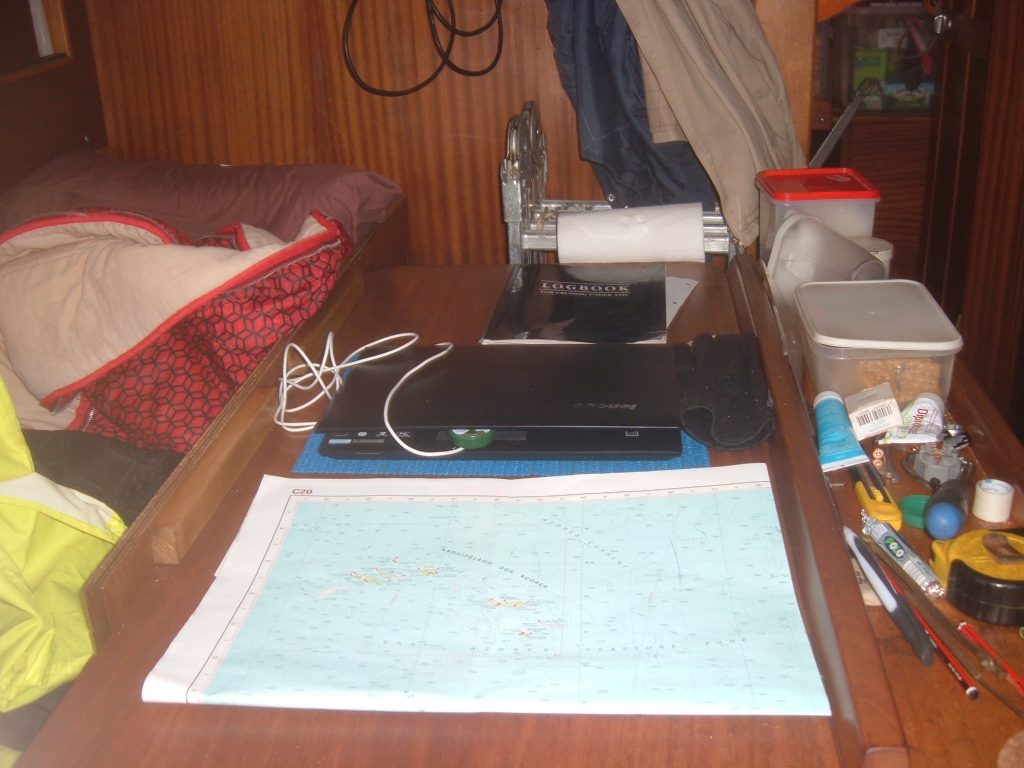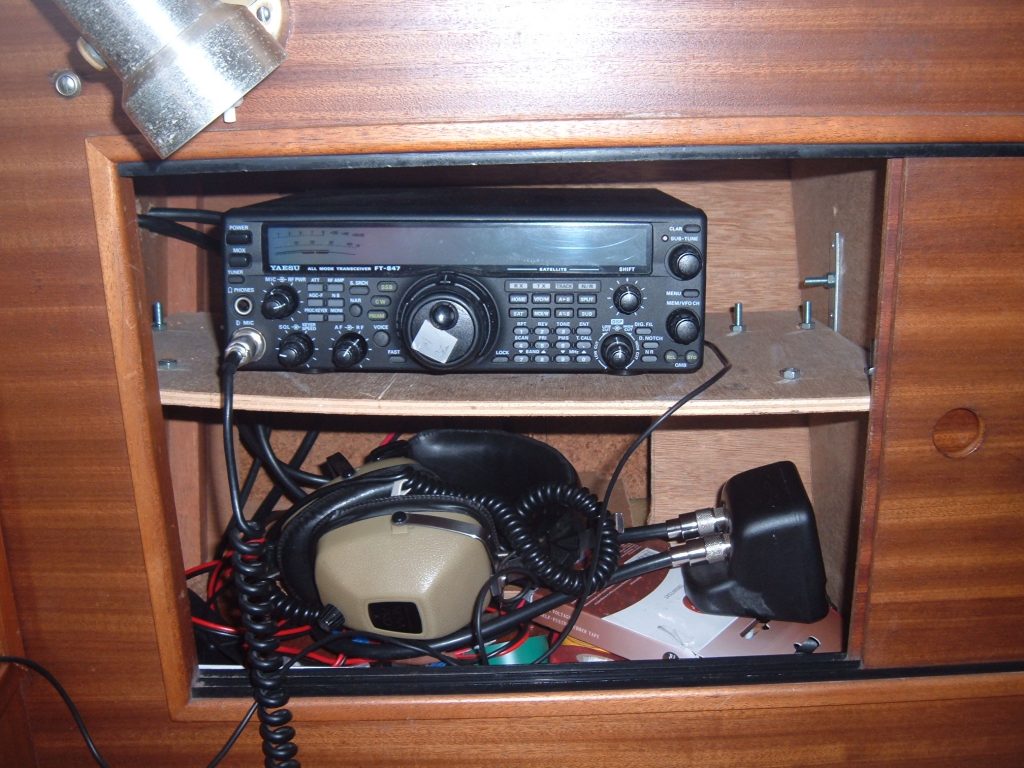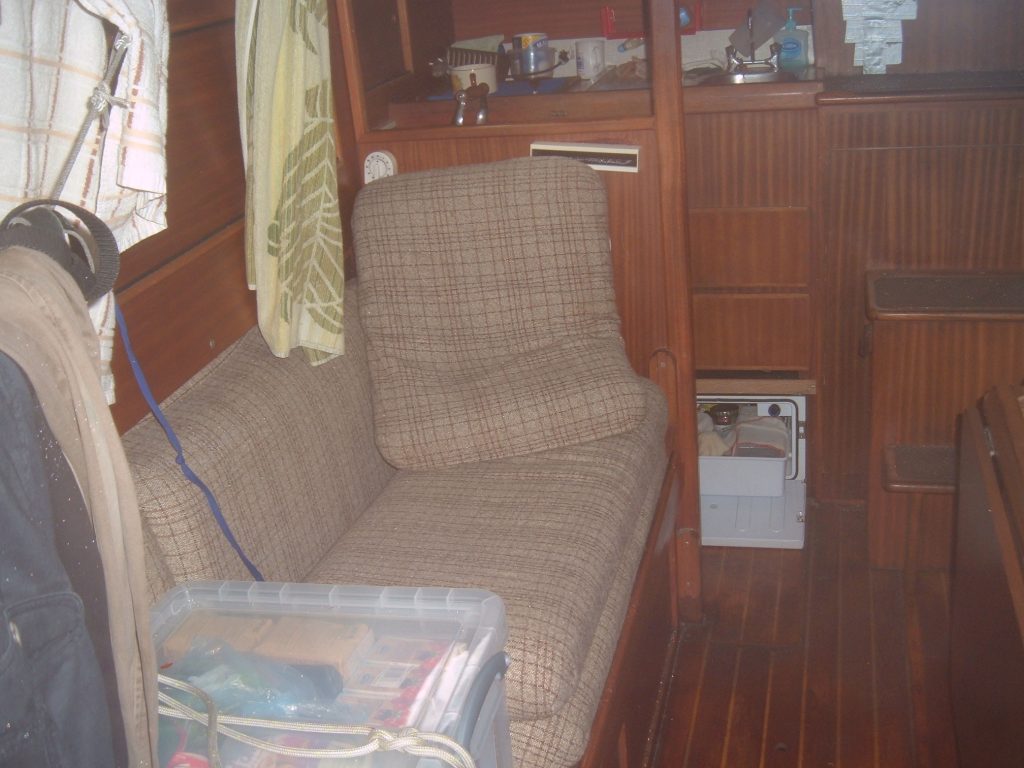The Outbound Journey
Some thoughts on the Jester Azores Challenge (JAC)2016.
1.
 Background:
Background:
As an elderly widower I usually sail alone. I’m not lonely, I enjoy the solitude and the only person I have to satisfy is me. Many years ago my Father told my wife that if
it wasn’t for her I would have become a recluse. So be it. I’m not anti-social – just not gregarious.
Why “Jester“. I was planning an Atlantic circuit and when I got to Insurance I found that nobody was willing to give me even ‘Third Party’ outside of my UK, Ireland and Near Continental cover. Then I read about the people who had managed to complete the Plymouth to Newport RI challenge (2014) and wondered who they went to for their insurance. After reading their website, it seemed that the only way I could get to talk to them was to join their organisation.
So I asked if I could, despite my yacht being too long to be a proper Jester, join in the short “taster” challenge (JBC) from Plymouth (or Pwllheli) to Baltimore (West Co Cork) in 2015. There were no apparent dissenters so the Colonel said yes.
I had to complete a solo voyage, 100 miles for the JBC and 500 for the JAC. This I did by doing a partial circumnavigation of Ireland starting at Milford Haven and standing off a sufficient distance to keep me clear of most of the shipping on the South, West and North coasts of Ireland. On passing north of Inistrahull I had covered 527 rhumbline miles plus a bit more for tacks made.
The JBC 2015 was little more than my normal Irish Sea “daysail,” notable to me for the enforced rests due to lack of wind. Then it was dowse all sail and head on pillow.
Jester Azores Challenge 2016.
Preparation:
So, I was hooked. My name duly appeared on the initial contenders list and I started preparing. Not all my Imray charts were in date but a few new ones made a lot of difference. My off-shore charts were all 2nd hand, mostly in date but not up-to-date BA.
 I like to use charts of a suitable scale instead of a plotting sheet. My running rigging needed washing and some was due for end-for-ending. A deal was struck with my Underwriters for the period needed and it wasn’t as expensive as I had first thought. After a full “Out of the Water Survey” they also gave me “Fully Comp” with an excess of £1500. Ah! but I had to have radar and an AIS transponder. E-bay solved those 2 problems at a reasonable price. I also purchased, new from the French makers, a “Mer-veille” radar detection system. Navigationally I was well set up: 2 GPS, 2 Battery GPS, Seafix direction finder and my trusty sextant. Now you’ll say the radio beacons around Europe have been removed. Well, OK but there are several DGPS stations (nearest is a Nash Point!) and the Azores has an aeradio beacon.
I like to use charts of a suitable scale instead of a plotting sheet. My running rigging needed washing and some was due for end-for-ending. A deal was struck with my Underwriters for the period needed and it wasn’t as expensive as I had first thought. After a full “Out of the Water Survey” they also gave me “Fully Comp” with an excess of £1500. Ah! but I had to have radar and an AIS transponder. E-bay solved those 2 problems at a reasonable price. I also purchased, new from the French makers, a “Mer-veille” radar detection system. Navigationally I was well set up: 2 GPS, 2 Battery GPS, Seafix direction finder and my trusty sextant. Now you’ll say the radio beacons around Europe have been removed. Well, OK but there are several DGPS stations (nearest is a Nash Point!) and the Azores has an aeradio beacon.
I loaded a mountain of food, canned, bottled and dry. 3 months plus for a two month voyage and I made the mistake of not keeping a proper inventory so I double stored some items. You want “5-beans” or tomatoes – I’m your man! 200 litres of drinking water (some in plastic containers) and 200 litres of fuel (some in a separate emergency fuel “tank”).
2.
For long distance communications I had my Amateur Transceiver (Yaesu 847) in a handy saloon locker driving an SG 230 AMU in the aft cabin and a whip on the Pushpit/Taffrail/ Stern Guardrail made from a 6 metre roach pole with a 2mm diameter solid copper wire inside. I also took various other portable and handhelds and a selection of conventional antennae, wire and “mobile” whips. Despite the ministrations of Ross/GW3NWS and Steve/GW4BLE we managed to miss each other and I admit to letting the requirement to copy weather messages, faxes, etc and eat/sleep and work the ship get in the way of amateur activities. The original trial in the Bristol Channel with Ross controlling was OK in ideal conditions but “out there” things were a bit different.
 At the last minute I was asked to get a Satphone. OK but a new modern phone costs big money (on a pensioner’s budget). Once again I turned to e-bay and for £100 got a Motorola 9500 with all sorts of extras (puck, data socket, etc.) I didn’t realise until I reached Plymouth that I could read SMS and emails but I couldn’t send them without a short course in computer technology. 100 minutes/3months airtime cost me £216.
At the last minute I was asked to get a Satphone. OK but a new modern phone costs big money (on a pensioner’s budget). Once again I turned to e-bay and for £100 got a Motorola 9500 with all sorts of extras (puck, data socket, etc.) I didn’t realise until I reached Plymouth that I could read SMS and emails but I couldn’t send them without a short course in computer technology. 100 minutes/3months airtime cost me £216.
On the outward voyage I reported my noon position daily to a young lady (a complete land lubber*) of my acquaint who found a whole organisation waiting with bated breath. Coming back it was a bit more relaxed. My (Our) thanks to Eric Andlauer for running our bit of Ocean Racetrack.
* Her words. Her last cruise was with Cunard!
The Challenge:
It is a challenge not a race. There is a start line and a gun and an arrival order but it is not a race. It is you and your boat against the ocean. I have long held the view (since the Singapore Round-the-Island Race 1964 backed up by various events such as Fastnet ‘79) that racing under sail is often the epitome of bad seamanship, unsporting actions and/or ungentlemanly conduct.
The Outward Leg:
On the way to Plymouth, just after rounding Lands End the weak-link on my Aries Gear gave up. Our local stockist is Mactra Marine in Weston-super-Mare so I thought it sensible to go back to Ilfracombe for a replacement. I later found out that there would be a delay beyond the start gun but Ilfracombe is a fishing port and I knew I could find a welder there. He didn’t have suitable aluminium tubing so, time being short, he welded up the old one and I caught the next tide south.
Our hosts were the Tamar River Sailing Club and I was allocated a spare trot mooring within easy rowing distance of their pontoon. I made it in time for a top-up of fresh veg and water before the BBQ. I felt the need to top-up my fuel but most of the marinas were out of the red stuff. I finally found some on the way down-river to the start line. £92 for what cost me £76 at Cardiff Bay YC – so stop your moaning and grumbling about the price of fuel.
The most dangerous part of any solo voyage must surely be “in soundings” but the weather was fair and the wind favourable to get out over the 500 metre line and away from the fishermen. There were 50 or so who expressed an intention but only 25 made it across the start line (at the start time!) Even with so many challengers many were soon out of sight (mostly ahead of me) but VHF kept us in touch for some time.
3.
There was lots of pre-start advice from all sorts of people. Go west then turn south at the Fastnet, go down to Lisbon and turn west, take the rhumbline if the wind allows. I plotted all three options on my BA 4103 and initially chose the direct route. As soon as I was in the clear I went to 15 minutes on the Kitchen Timer.
 For those of you who have never sailed solo – you can’t wait for night or until you are tired – you start your rest routine as soon as you safely can. Some people set up “Alarm Bands” on their AIS, Radar, etc and then actually get into their bunk for regular sleep of up to 6 hours but I prefer to keep things simple and easy. I have two rest stations, each being the end of whichever saloon bunk is ‘down‘. A spare seat biscuit, pillow and a hook to hang the timer on (as close as possible to your best ear). This is not sleep alone. Making drinks, meals, etc take up some of your “rest” time.
For those of you who have never sailed solo – you can’t wait for night or until you are tired – you start your rest routine as soon as you safely can. Some people set up “Alarm Bands” on their AIS, Radar, etc and then actually get into their bunk for regular sleep of up to 6 hours but I prefer to keep things simple and easy. I have two rest stations, each being the end of whichever saloon bunk is ‘down‘. A spare seat biscuit, pillow and a hook to hang the timer on (as close as possible to your best ear). This is not sleep alone. Making drinks, meals, etc take up some of your “rest” time.
This is just time not keeping a lookout. The further you think you are from danger, the longer the period allowed but I must follow the Law as best I can. Not Colregs Rule 5 but the original reason for ordering vessels to maintain a good lookout. For survivors of shipwreck*. To that end I spend as much time as I can perched under my sprayhood – even eating my meals there. When I need to sleep I have an announcer (old fashioned BBC style) in my head to give me a prompt (3,2,1 relax). It is, I think, a sort of self-hypnosis. Even in mid-ocean I don’t get into my bunk unless all my sails are dowsed.
*One day it might be You or even worse – ME.
The first problem I encountered, within minutes of crossing the start line, was the failure of my AIS/VHF auto-switch unit. No problem – AIS transponder fed into an amateur-band aerial atop the mizzen mast with a similar frequency coverage (2 Metre band close by the maritime VHF band). I will squawk and (hopefully) be seen.
Anyone who took part in the Challenge will tell you that we encountered 4 gales on our way down but that’s not the whole truth. Only for two short periods did I log the wind as Force 8. ^For the other two gales most of us managed to skirt around them so lots of force 5 and 6/7 and heavy seas (some of which tried to climb inboard with varying success). Off (Spanish) Finisterre I was even becalmed overnight and got a good night’s sleep.
The run across from there to the Azores was generally OK. Few ships were sighted but the weather wasn’t going to let me pass unhindered and there was another gale to endure while transiting the archipelago. Whatever happened to the “Azores High?”
^ The saying is true – “Passage plans rarely survive the first gale”.
I had 3 systems for charging my batteries but they don’t always work so well. The primary method is running the main engine but that is expensive and there are limitations as to its use, in that if the boat rolls more than 30 degrees the luboil pump might lose suction. I have a “towed” alternator but at slow speeds the output is very poor. I have two solar panels which I can move around to catch the best sun.
So – there I was with a Force 8 forward of the beam (heavy rolling and slow speed) and lots of rain and spray instead of sun. The fourth, a small wind turbine, I had left behind due to the noise it makes and even then its low output. A suitcase generator is a definite No No under those weather conditions.
4.
I was losing my electricity needed for safety systems and the only way to preserve it was to switch off the fridge, eat up the contents and use the old “cheese- cloth” cooler for the milk and butter.
Then, as the gale slowly abated came another heavy blow – my 150% genoa, furled to the shrouds, tore on the spreader tip after throwing off one of the wheels. By the time I had furled the damaged section onto the foil I had the same area of sail forward as I had on the mizzen. This was giving me about 2 knots towards Terceira (and only 200 miles to go, against the current!). A bit of a struggle got the Main hoisted to the reefpoint (Where it got caught by an errant wire pennant and remained thus until just before arrival) and the Storm Jib on the ’Baby-stay’.
The gale continued overnight and I considered a diversion to Punta Delgada on the south coast of Sao Miguel but the wind eventually dropped to a F5/6 so I was able to get a spare furling jib up on deck. Of course, to lower the damaged sail I had to unfurl it first. Lots of cracking and banging as it streamed down the lee side while I went forward to weather, having first shook out the inboard end of the halyard, stuffed my pockets with lashing lines and removed some of my clothing. I knew I was going to get very wet so I left some of my outer gear under the sprayhood.
The genoa came down quickly and once I had secured all three corners on deck, plus lashing the halyard to the pulpit, I worked one corner at a time towards the aft cabin. (I had visions of being carried away on an impromptu magic carpet ride). Hoisting the spare sail required one hand to gather and one to feed into the foil slot. To hoist the sail I brought the halyard to the windlass and by lying on the deck (very wet but the water is warmer that far south) I could work the windlass with my feet. I made one mistake – I shackled the head of the sail directly onto the halyard swivel. More about that later.
As I closed Terceira the wind eased and went to the W. The current from the WNW. Professor Soddes Law. My Tack angle was so wide that unless I kept in the lee of the island I would never make the harbour. The only thing to do was keep plugging away until the forces against me waned or shifted. A stroke of luck (maybe an eddy of the current around the end of the island) and whoosh! I was there. As I started to lower my sails I found my genoa with a halyard-wrap. One mile from the entrance – managed to untie the lazy sheet from the genoa and cut the bowline on the working sheet.
Engine On! The Jesters who had arrived before me were now on the marina breakwater wondering why I was going around in circles. Well it’s the only way I know to furl a sail with a jammed furler when the clew is 8 feet off the deck!
When I went on the arrival berth I expected reams of paperwork but was left to be manhandled around impossible knuckles and other boats into a berth by the Jesters and others in the marina. The paperwork could wait until after lunch. Well after (Some time between High Tea and Dinner.) Laid back but efficient and thorough.
I was the fifth to arrive and two more arrived while I was there. 3 others made it after I left. None of the starters went missing. Success!
5.
Mistakes:
Keep an accurate food loading inventory. I’ll be eating my voyage victuals until Christmas. That includes 2 individual christmas puddings, taken for meals such as my birthday lunch.
My spare genoa came off a boat with a shorter forestay and I wanted to set it low so I should have put a pennant on the head to keep the swivel close to the halyard restraint.
I’ll take a third solar panel and my little wind turbine next year. It all adds up to a usable house battery (2 x 110Ah). Plus a 110Ah starter battery and a spare (normally kept charged but isolated) in the after cabin.
PS If you want to join the Jester Group google “Jester Challenge”. 2017 is to Baltimore, West Co Cork, dates to be announced, arrival to coincide with “Pirate Week.”(Google that too!)
Doug Pingel “Jekeeda 2” Westerly 33 Nr191
